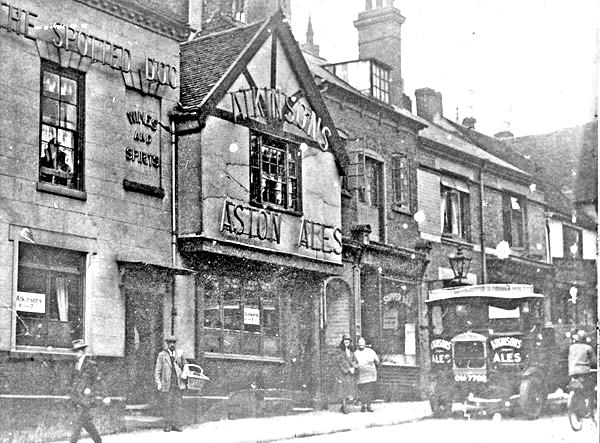Dog, Butcher Row
| Alternative Addresses: | 12-13 Bull Ring | ||
| These premises have been known by different names during their history: | FROM | TO | NAME |
| 1704 | ? | Dog | |
| 1802 | c1822 | Chicken | |
| c1822 | 1841 | Dog | |
| 1835 | 1934 | Spotted Dog | |
| 1868 | Peeping Tom Vaults | ||
| c1876 | Dew Drop | ||
 The Spotted Dog, 12-13 Bull Ring.
This is a common pub name, usually a reference to hunting.
The gate house through which access was gained to the precincts of the monastery, the Cathedral and priory stood on this site until being pulled down in 1704 by workmen working for Mrs Cave King. The council issued an order for Mrs King to give financial restitution and to rebuild the 'stone arch leading to Priory Court'. After some litigation the ground was sold to Mrs King and the Dog erected on the site.
Here in 1424 the council ordered the making of a bull ring so that nearby butchers could bait bulls before slaughter. The Bull Ring suffered the same fate as Butcher Row, i.e. it is now under Trinity Street.
The Spotted Dog was 12 and 13 Bull Ring, where it joined Butcher Row - one of a row of small properties between Priory Row and New Buildings. In 1929 the license of the Spotted Dog was moved, with that of the White Swan, Hill Street, tp premises to be erected on Beech Tree Avenue, that is the Newlands Hotel.
In 1806 The premises was the meeting place of the Provincial Grand Lodge of Warwickshire (Freemasons).
There is a record that the CHICKEN, Bull Ring changed to the DOG, Butcher Row in 1822.
The pub closed in 1930 and was demolished in 1934 in order for the new wide thoroughfare of Trinity Street to replace Butcher Row. During the demolition the west archway of the first Coventry Cathedral was uncovered.
The small properties, including the Spotted Dog, were all replaced by one large black and white building. This was designed to match the old cottages in Priory Row. The English oak for the framework came from Harborough Magna and woodcarving was by Louis and Maurice Harvard from France. Although the exterior was completed in 1938/39, the interior was not fitted out until ten years later due to the war. For many years it was Samuel's the jewellers and Timothy Whites chemists, then in 1999 it became Wetherspoon's Flying Standard.
The Spotted Dog, 12-13 Bull Ring.
This is a common pub name, usually a reference to hunting.
The gate house through which access was gained to the precincts of the monastery, the Cathedral and priory stood on this site until being pulled down in 1704 by workmen working for Mrs Cave King. The council issued an order for Mrs King to give financial restitution and to rebuild the 'stone arch leading to Priory Court'. After some litigation the ground was sold to Mrs King and the Dog erected on the site.
Here in 1424 the council ordered the making of a bull ring so that nearby butchers could bait bulls before slaughter. The Bull Ring suffered the same fate as Butcher Row, i.e. it is now under Trinity Street.
The Spotted Dog was 12 and 13 Bull Ring, where it joined Butcher Row - one of a row of small properties between Priory Row and New Buildings. In 1929 the license of the Spotted Dog was moved, with that of the White Swan, Hill Street, tp premises to be erected on Beech Tree Avenue, that is the Newlands Hotel.
In 1806 The premises was the meeting place of the Provincial Grand Lodge of Warwickshire (Freemasons).
There is a record that the CHICKEN, Bull Ring changed to the DOG, Butcher Row in 1822.
The pub closed in 1930 and was demolished in 1934 in order for the new wide thoroughfare of Trinity Street to replace Butcher Row. During the demolition the west archway of the first Coventry Cathedral was uncovered.
The small properties, including the Spotted Dog, were all replaced by one large black and white building. This was designed to match the old cottages in Priory Row. The English oak for the framework came from Harborough Magna and woodcarving was by Louis and Maurice Harvard from France. Although the exterior was completed in 1938/39, the interior was not fitted out until ten years later due to the war. For many years it was Samuel's the jewellers and Timothy Whites chemists, then in 1999 it became Wetherspoon's Flying Standard. | |||
LICENSEES:1828 - 1829 Richard Evans | |||
 Street plan of 1851 | |||